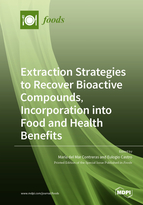Extraction Strategies to Recover Bioactive Compounds, Incorporation into Food and Health Benefits
A special issue of Foods (ISSN 2304-8158). This special issue belongs to the section "Food Security and Sustainability".
Deadline for manuscript submissions: closed (31 December 2019) | Viewed by 24237
Special Issue Editors
Interests: bioactive compounds; functional foods; valorization; agri-food waste; phenolic compounds
Special Issues, Collections and Topics in MDPI journals
Interests: agricultural residues; lignocellulosic materials; sugars; biorefineries; bioproducts
Special Issues, Collections and Topics in MDPI journals
Special Issue Information
Dear Colleagues,
The general purpose of this Special Issue, “Extraction Strategies to Recover Bioactive Compounds, Incorporation into Food, and Health Benefits”, is to expand the information on bioactive compounds when applied to the food industry. Therefore, the objectives are: To address new ways to extract bioactive compounds (phytochemicals, proteins, peptides, fatty acids, etc.) from raw material in a sustainable way and using food grade conditions, to incorporate these bioactive compounds into the food matrix, and to evaluate their health benefits. There are numerous studies in literature on different bioactive products (extracts, essential oils, oleoresins, hydrolysates, etc.) that possess numerous health benefits against diseases and disorders of the cardiovascular, respiratory, digestive system, etc. Therefore, this Special Issue will discuss ways to recover different bioactive types and to incorporate them into the food matrix. Moreover, the health benefit has to be supported in the food. Furthermore, the valorization of agri-food waste is a challenge and obtaining bio-based products based on bioactive compounds is a plausible way. We are particularly interested in studies focusing on the extraction of bioactive compounds, including antioxidants, from agri-food residues and guided at the study of their health benefits and functional food applications.
Dr. María del Mar Contreras
Prof. Dr. Eulogio Castro
Guest Editors
Manuscript Submission Information
Manuscripts should be submitted online at www.mdpi.com by registering and logging in to this website. Once you are registered, click here to go to the submission form. Manuscripts can be submitted until the deadline. All submissions that pass pre-check are peer-reviewed. Accepted papers will be published continuously in the journal (as soon as accepted) and will be listed together on the special issue website. Research articles, review articles as well as short communications are invited. For planned papers, a title and short abstract (about 100 words) can be sent to the Editorial Office for announcement on this website.
Submitted manuscripts should not have been published previously, nor be under consideration for publication elsewhere (except conference proceedings papers). All manuscripts are thoroughly refereed through a single-blind peer-review process. A guide for authors and other relevant information for submission of manuscripts is available on the Instructions for Authors page. Foods is an international peer-reviewed open access semimonthly journal published by MDPI.
Please visit the Instructions for Authors page before submitting a manuscript. The Article Processing Charge (APC) for publication in this open access journal is 2900 CHF (Swiss Francs). Submitted papers should be well formatted and use good English. Authors may use MDPI's English editing service prior to publication or during author revisions.
Keywords
- Antioxidants
- Bioactive compounds
- Fatty acids
- Food grade
- Functional food
- Healthy food
- Carotenoids
- Phenolic compounds
- Peptides
- Sustainability








